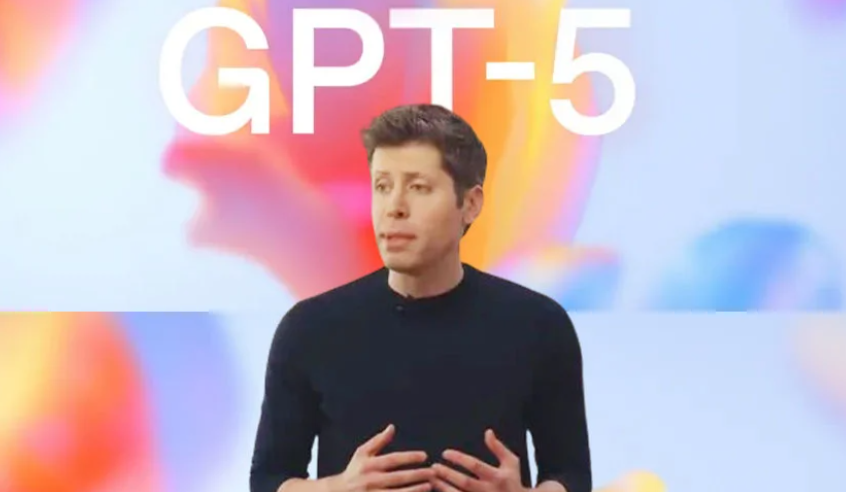Currently Empty: £0.00
Blog
ChatGPT 5: The unified AI revolution arrives with mixed fanfare

ChatGPT 5 officially launched on August 7, 2025, marking OpenAI’s most significant model release since GPT-4. The new system unifies reasoning and speed into a single intelligent platform, delivers substantial performance improvements across coding and analysis tasks, and extends access to advanced AI reasoning for free users for the first time. However, the reception has been notably more tempered than previous releases, with users and experts praising technical progress while noting it represents evolutionary rather than revolutionary advancement.
The launch introduced multiple model variants through a unified system that automatically switches between fast responses and deeper “thinking” modes, achieved state-of-the-art coding performance with 74.9% accuracy on software engineering benchmarks, and reduced hallucination rates by 45% compared to GPT-4. OpenAI positions this as a major step toward their five-level AGI roadmap, moving from Level 1 (chatbots) toward Level 2 (reasoners), though experts remain divided on whether it represents meaningful progress toward artificial general intelligence.
Official launch delivers unified AI system architecture
OpenAI unveiled ChatGPT 5 during an hour-long livestream on August 7, 2025, following cryptic teasers including Sam Altman’s Death Star imagery that generated significant pre-launch anticipation. The release represents a fundamental shift from previous single-model approaches to what OpenAI calls a “unified system” that combines multiple capabilities.
The core innovation lies in real-time intelligent routing that automatically determines whether queries require fast responses or deeper reasoning analysis. This eliminates the need for users to manually select between different models, instead providing an adaptive system that engages chain-of-thought reasoning when beneficial for complex problems while maintaining speed for routine tasks.
The launch included five distinct model variants: GPT-5 (main reasoning model), GPT-5-mini (lightweight efficiency), GPT-5-nano (ultra-low latency), GPT-5-chat (conversational optimization), and GPT-5-thinking (extended reasoning). Each variant serves specific use cases while sharing the unified architecture that represents OpenAI’s attempt to create a more intuitive and capable AI assistant.
Immediate availability rolled out to ChatGPT Plus, Pro, and Team users, with free users gaining access to 10 GPT-5 messages every five hours plus one daily GPT-5 Thinking message. Enterprise and educational users received access approximately one week after the consumer launch, while API access became available immediately across three primary variants.
Performance breakthroughs showcase reasoning and coding excellence
GPT-5’s technical capabilities demonstrate significant advances across multiple domains, with particularly notable improvements in mathematical reasoning and software engineering. On the AIME 2025 mathematics benchmark, the system achieved 94.6% accuracy, while software engineering performance reached 74.9% on SWE-bench Verified – substantially outperforming GPT-4’s 30.8% on the same measure.
The multimodal understanding capabilities show marked improvement, with 84.2% accuracy on MMMU compared to GPT-4’s 72.2%, while specialized health applications achieved 46.2% accuracy on HealthBench Hard. Perhaps most importantly for reliability, hallucination rates dropped by 45% compared to GPT-4, with the thinking mode achieving an 80% reduction in factual errors compared to the previous o3 model.
Revolutionary “Vibe Coding” Capabilities
Coding demonstrations during the launch showcased “vibe coding” capabilities where single paragraph prompts generated complete web applications, including a French learning app and interactive games with responsive design. The system demonstrated particular excellence in frontend development, creating aesthetically pleasing interfaces with proper functionality from minimal input.
During the livestream, OpenAI’s Yann Dubois demonstrated how GPT-5 could create a complete French learning web application in under 15 seconds. The app included flashcards, pronunciation exercises, and an interactive game where users guide a mouse to cheese while learning vocabulary – all generated from a single conversational prompt.
Technical specifications include a 256,000 token context window (equivalent to 600-800 page books), 128,000 token output capability, and architecture prepared for future integration with video processing through SORA. The training approach combined large-scale supervised learning with enhanced reinforcement learning from human feedback, built on Microsoft’s Azure AI supercomputing infrastructure using advanced GPU clusters.
Aggressive pricing strategy targets market leadership
OpenAI introduced competitive pricing across all tiers, maintaining the industry-standard $20 monthly rate for Plus subscribers while launching a premium $200 Pro tier targeting researchers and power users. The Pro tier provides unlimited GPT-5 access plus GPT-5 Thinking Pro, 120 monthly deep research queries, and priority access to upcoming features including OpenAI’s Operator agent and Sora video generation.
API pricing positions OpenAI competitively at $1.25 per million input tokens and $10 per million output tokens for GPT-5, with mini and nano variants offering lower-cost alternatives for different use cases. Token caching provides up to 90% discounts on cached inputs, while batch processing offers 50% savings for asynchronous workloads – strategies designed to attract developer adoption and potentially trigger industry price wars.
Business pricing remains structured around team ($25-30 per user monthly) and enterprise (approximately $60 per user monthly) tiers, with minimum user requirements and comprehensive administrative controls. The enterprise offering emphasizes security, compliance, and integration capabilities essential for large organization deployment.
Global availability follows a phased rollout beginning with the United States, expanding to Canada and select European countries, then broader international markets over subsequent weeks. Microsoft integration provides immediate access through 365 Copilot, GitHub Copilot, and Azure AI Foundry, leveraging the partnership’s extensive enterprise relationships.
Mixed reception highlights gap between expectations and delivery
User and expert reactions reveal significant polarization despite clear technical improvements. A Reddit thread titled “GPT-5 is horrible” garnered nearly 3,000 upvotes within 24 hours, with users expressing frustration over losing access to previous model variants they found more reliable for specific tasks. Many ChatGPT Plus subscribers felt the unified approach actually reduced functionality by eliminating manual model selection.
Professional assessments proved more measured, with MIT Technology Review characterizing GPT-5 as “a refined product” rather than a major technological breakthrough. Industry experts praised specific improvements while noting the lack of paradigm-shifting capabilities that defined earlier releases. Simon Willison called it “my new favorite model” but emphasized it remains “still an LLM” without dramatic departures from existing limitations.
The launch presentation itself generated controversy when analysts identified scaling errors in OpenAI’s benchmark charts, dubbed “chart crime” by data visualization experts. This technical misstep undermined credibility during a launch where Altman’s pre-release imagery had created expectations for revolutionary change that the actual capabilities didn’t fully meet.
Despite criticisms, certain constituencies responded positively. Developers appreciated the competitive API pricing and improved coding capabilities, while free users welcomed access to reasoning functionality for the first time. Early access testers including enterprise partners reported satisfaction with reliability improvements and reduced hallucination rates in practical applications.
Competitive landscape intensifies with closer performance gaps
ChatGPT 5’s market positioning faces stronger competition than previous OpenAI releases, with Anthropic’s Claude, Google’s Gemini, and integrated Microsoft offerings providing viable alternatives across different use cases. Benchmark comparisons show GPT-5 maintaining slight edges in some areas while trailing in others, suggesting the era of clear AI model dominance may be ending.
Against Anthropic’s Claude, GPT-5 demonstrates superior reasoning capabilities and broader multimodal support, while Claude maintains advantages in certain coding tasks and safety profiles. Pricing parity at $20 monthly subscriptions forces differentiation on technical capabilities, ecosystem integration, and user experience rather than cost alone.
Google’s Gemini benefits from deep workspace integration and competitive pricing bundled with storage services, while Microsoft’s partnership with OpenAI provides enterprise distribution advantages. The competitive dynamics suggest organizations will increasingly choose based on specific use cases rather than overall superiority, as performance gaps narrow across major providers.
Prediction markets shifted favorably toward Google following GPT-5’s launch, indicating some investor skepticism about OpenAI’s continued technical leadership. This market response, combined with the lukewarm expert reception, suggests the AI industry may be entering a phase where substantial progress exists alongside more realistic expectations about breakthrough innovation pace.
Key visual elements from the GPT-5 launch
Official Branding and Design Language
The GPT-5 launch introduced a refreshed visual identity featuring rainbow-textured logos that blend pink and blue gradients across the model family (GPT-5, GPT-5-mini, GPT-5-nano, and GPT-5-chat). This represents OpenAI’s most significant branding evolution since the company’s founding, moving away from the monochromatic approach used in previous releases.
Interface and User Experience Updates
The new unified interface eliminates the confusing model picker dropdown, automatically routing queries to appropriate model variants based on complexity. This “Apple-y” design philosophy prioritizes user simplicity over technical transparency, representing a fundamental shift in how OpenAI presents AI capabilities to mainstream users.
Demo Screenshots and Technical Presentations
Key visual content from the launch includes:
- Vibe Coding Demonstrations: Screen recordings showing complete web applications generated from single prompts
- French Learning App: The flagship demo application featuring flashcards, pronunciation tools, and interactive games
- Benchmark Performance Charts: Technical comparison data (though these drew criticism for visualization errors)
- API Documentation: Developer-focused screenshots showing the new pricing tiers and model variants
Visual content strategy supports comprehensive coverage
High-quality visual materials for blog coverage include official OpenAI logos featuring rainbow textures blending pinks and blues, representing the company’s new design direction for the GPT-5 family. Livestream screenshots capture compelling demo content including “vibe coding” demonstrations where single prompts generated complete web applications, French learning apps, and interactive games with sophisticated interfaces.
Professional press photography from the launch event provides credible executive imagery, while technical documentation screenshots illustrate API capabilities and developer resources. Performance benchmark charts require careful sourcing – OpenAI’s original charts contained scaling errors criticized by data visualization experts, making third-party recreations from sources like Vellum.ai more reliable for analytical sections.
Interface evolution screenshots demonstrate tangible improvements in user experience, while before-and-after coding demonstrations provide powerful visual proof of capability advances. Press coverage from major outlets offers additional professional imagery, though proper attribution and licensing verification remains essential for commercial blog use.
Looking ahead: evolutionary progress toward ambitious goals
ChatGPT 5 represents a significant technical achievement that advances OpenAI’s stated AGI roadmap while falling short of the revolutionary transformation many anticipated. The model demonstrates clear progress from Level 1 (chatbots) toward Level 2 (reasoners) in OpenAI’s five-level framework, though experts debate whether current improvements constitute meaningful advancement toward artificial general intelligence.
OpenAI’s near-term roadmap includes the January 2025 launch of their Operator AI agent for autonomous web tasks, continued integration across Microsoft’s product suite, and the gradual rollout of video processing capabilities through SORA integration. The company expects AI agents to “join the workforce” in 2025, representing the next phase of practical AI deployment beyond conversational interfaces.
The reception patterns suggest the AI industry may be maturing beyond the revolutionary excitement of earlier releases toward more measured evaluation of incremental improvements. GPT-5 succeeds as a refined product offering better user experience, improved safety, and broader accessibility, but the gap between marketing promises and delivered capabilities highlights the ongoing challenges of expectation management in rapidly evolving AI development.
For organizations evaluating AI solutions, GPT-5 provides a compelling unified platform with competitive pricing and broad capability improvements. However, the mixed reception and strong competitive alternatives suggest careful evaluation based on specific use cases rather than assumed superiority will become increasingly important as the AI landscape continues maturing.




